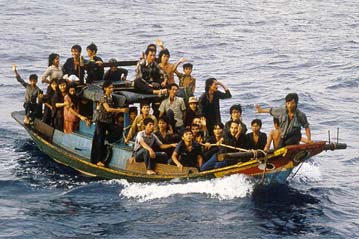Vietnam: The Other Side by Duong Nguyen
 Since the communist takeover of South Vietnam on April 30, 1975, many writers have produced books about various aspects of the Vietnam War. Duong Nguyen—a medical doctor who fled his homeland in 1975 and lives in the United States—presents a unique, first-hand account of a country in transition in Vietnam: The Other Side, Challenging All Odds (CreateSpace Independent Publishing, 218 pp., $23, paper). This autobiographical novel is told through the coming-of-age eyes of a child and his prosperous Hanoi family disrupted by the division of their country after the defeat of the French at Dien Bien Phu in 1954.
Since the communist takeover of South Vietnam on April 30, 1975, many writers have produced books about various aspects of the Vietnam War. Duong Nguyen—a medical doctor who fled his homeland in 1975 and lives in the United States—presents a unique, first-hand account of a country in transition in Vietnam: The Other Side, Challenging All Odds (CreateSpace Independent Publishing, 218 pp., $23, paper). This autobiographical novel is told through the coming-of-age eyes of a child and his prosperous Hanoi family disrupted by the division of their country after the defeat of the French at Dien Bien Phu in 1954.
Uprooted from their spacious and opulently furnished home, the family hastily boards a flight to Saigon. never to return. Attempting to minimize the trauma, the main character Dang’s parents enroll him in a prestigious French school in which Vietnamese is considered a foreign language and the history curriculum emphasizes all things French. Dang relies on news reports on the war as it intensifies after 1964 with the American involvement.
Dang has some difficulty adjusting to his southern neighbors and is teased about his accent, but this criticism later subsides.
The culture in Saigon is corrupted by the arrival of Americans and their PXs and the black market and everyone’s desire for consumer goods. Many families resort to prostitution and profiteering just to survive. Amid this “westernized” Saigon atmosphere Dang completes high school and passes his medical school admissions exam even though his first choice is to be a pilot.
When his first year of medical school is completed he decides to commit to the Army of the Republic of Vietnam so that his tuition would be paid. In his fifth year of medical
school Dang meets his first love, a Peace Corp physician named Mary. To reveal the outcome would spoil the book for readers.
Soon after the 1968 Tet Offensive Dang graduates as a physician and is assigned to the 9th ARVN Infantry in IV Corps area in the relatively quiet Mekong Delta near Vinh Binh. “Rats ran unmolested everywhere with no fear of man and the food supplies were usually contaminated with rodent droppings, ” Duong Nguyen writes. “Insects of various sorts were ubiquitous and tended to be ignored. This was kind of a cold shower for Dang, who was reared in comfortable urban and modern life.”
Finishing two years of combat duty Dang is transferred to the Air Force at Phan Rang just prior to what he describes as the “debacle.” Dang witnesses the sudden and final collapse of The Republic of South Vietnam.
Dang joins many former ARVN troops and South Vietnamese government officials in communist re-education camps after he decides to register with the local police station. He tells his family: ” I will be back in a couple of days.” But he is held for three years. When released he is relatively healthy but extremely underweight.

Vietnamese fleeing the country in the late seventies
A few days under the oppressive regime is all it takes for Dang to begin planning his escape. “His parents were too old and could not make such a trip. His sisters were all married and living with their husbands’ families. His brothers were in prison, so there was only himself to worry about.”
This begins the novel’s most action-packed and suspenseful section, the page-turning conclusion. The reader will be taken back to the days of the Vietnamese “Boat People, ” a situation that is sadly similar to the plight of refugees in Europe today.
The author, Duong Nguyen, enlisted in the U.S. Army after migrating to this country, and commanded two medical units and was Division Surgeon of the 1st Armored Division during the first Persian Gulf War.

